
 Home Home
 Season's Greetings! Season's Greetings!
 The Economic Crisis: The Economic Crisis:
A Dog's Perspective
 About Those Hounds... About Those Hounds...
 Our Hounds Our Hounds
 Adopting a Friend Adopting a Friend
 Adoption Application Adoption Application
 Rescue of the Month Rescue of the Month
 Special Rescues Special Rescues
 The Bagel Shoppe The Bagel Shoppe
 The Old Age Page The Old Age Page
 Black Listed Beauties Black Listed Beauties
 Getting Involved - Volunteering Getting Involved - Volunteering
 The Ugly Truth The Ugly Truth
 Success Stories Success Stories
 Wishlist Wishlist
 The Homewoods Herald The Homewoods Herald
 Houndware Houndware
 Memorials Memorials
 Muchas Gracias Muchas Gracias
 Contact Contact

 Pryor's Planet Pryor's Planet
 Ritchie Co. Humane Society Ritchie Co. Humane Society
 Humane Society of North Central West Virginia Humane Society of North Central West Virginia
 Whimsical Animal Rescue Whimsical Animal Rescue
|
|



Members of the Hound Group
Catahoula Leopard Dog
Plott Hound
Bluetick, Redtick, Treeing Walker and Redbone, Black and Tan Coonhound
American Foxhound
English Foxhound
Basset Hound

Beagle
Deerhound
Otter Hound
Greyhound
Whippet
Harrier
Dunker
Haldenstovare
Hygenhund
Finnish Hound
Drever
Schillerstovare
Hamiltonstovare
Smalandsstovare
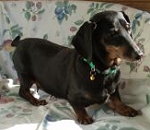
Minature Dachshund
Hanoverian Mountain Hound
Bavarian Mountain Hound
Polish Hound
Irish Wolfhound
Kerry Beagle
Lurcher
Bloodhound
Billy
Basset Fauve de Bretagne
Grand Bleu de Gascogne
Chien d' Artois
Basset Bleu de Gascogne
Basset Artesian Normand
Grand Gascon-Saintongeois
Grand Basset Griffon Vendeen
Briquet Griffon Vendeen
Griffon Nivernais
Petit Bleu de Gascogne
Petit Griffon Bleu de Gascogne
Anglo-Francais de Petite Venerie
Griffon Fauve de Bretagne
Porcelaine
Jura Laufhund: Bruno
Jura Laufhund : St. Hubert
Hungarian Greyhound
Schweizer Laufhund
Luzerner Laufhund
Balkan Hound
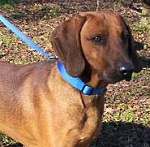
Rhodesian Ridgeback
Posavac Hound
Yugoslavian Mountain Hound
Yugoslavian Tri-colored Hound
Italian Hound
Cirneco Dell'Etna
Pharaoh Hound
Ibizan Hound
Sabueso Espanol
Spanish Greyhound
Podengo Potugueso Pequeno
Podebgo Potugueso Medio
Saluki
Borzoi
Azawakh
Afghan Hound
Sloughi
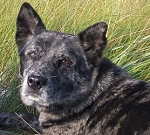
Kai Dog
|
My hounds are bred out of the Spartan kind,
So flewed, so sanded: and their heads are hung
With ears that sweep away the morning dew;
Crook-kneed, and dew-lapped like Thessalian bulls,
Slow in pursuit, but matched in mouth like bells,
Each unto each. A cry more tunable
Was never hollaed to, nor cheered with horn,
In Crete, in Sparta, nor in Thessaly:
Judge when you hear.
William Shakespeare
Midsummer Nightís Dream. Act IV, Scene I

The grouping of dogs known as hounds includes some of the worldís oldest breeds. In many cases their origins date back thousands of years with the earliest evidence of their existence coming from Egypt, where portrayals of hounds with a striking similarity to certain contemporary breeds have been noted on ancient artifacts. Over the years, many new breeds have been developed for a variety of purposes. They have also been evolved to work in a wide range of landscapes, with some, such as the Greyhound, being bred for their pace, while many, like the Beagle and Bloodhound, are valued for their scenting skills and stamina.
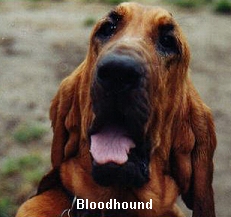
Both sight-hounds and scent-hounds have a highly developed hunting instinct: sight-hounds can be expected to chase cats or anything else that runs away, including smaller dogs. Sight-hounds are bred for speed, scent-hounds for stamina: all hounds need regular exercise and some need a great deal of space. But a large houndís over-developed cardiovascular system can also make it prone to heart attack and stroke so it may have a relatively short life: although some individuals live to a ripe old age, some can die very young and the average lifespan is slightly on the short side.

Sight-hounds can make good household pets as long as they have wide open spaces for a good daily run. A short-legged scent-hound also needs lots of time outdoors to satisfy itís tracking instinct. Scent-hounds (especially Bassets) can be slaves to their noses: given an opening, they are apt to stray far from home.
Not all hounds are large. Short legs help to bring a scent-houndís nose a little nearer to the ground but the point of diminishing returns is reached when the back begins to take some of the strain of walking, forcing it to flex sideways with each stride. Short legs plus a long back can therefore lead to the disc problems that are frequently seen in Dachshunds and Bassets. Some Dachshunds, whose short legs once carried them bravely into badger setts, have been diminished to a point where the nipples of a pregnant or nursing bitch may drag along the ground (like her ears) as she walks ( a most unfortunate predicament!)
What kind of a person should be "owned" by a hound? As much as we love and cherish these dogs, this is not the breed for everyone. There are many special considerations that must be taken into account before the decision to adopt is made.
A hound is not a breed for someone who may be put off by getting slobber on their clothing or furniture. Some of the scent hounds, particularly the males, have large pendulous lips and they will often shake their heads and the slobber will fly.
The Nature of the Hound
The "nature" of the hound...interesting wording. The implication in the wording is intentional. There are many myths and misconceptions about hound breeds. While each breed differs in purpose as much as they differ in form, there are consistencies through the hound family. The reason I chose to put this information here is quite simple. If you want to learn about the nature of the hound, one needs to look no further than the Coonhound. These dogs are the quintessential hound. Everything that makes a hound a hound, both good and bad, is right here in the Coonhound.
|
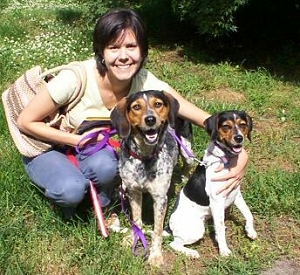 So what is the nature of a hound? The first issue that must be covered when discussing hounds is that hounds, much like Terriers, are not for everyone. People seem to think that a dog is a dog is dog and take little concern in the dog's breeding or instinctual tendencies for certain behaviors. The laid back, even temperament of the hounds make them perfect candidates for this mistake. Caution should be taken when considering any pure bred animal and the easy tempered hound is no exception.
So what is the nature of a hound? The first issue that must be covered when discussing hounds is that hounds, much like Terriers, are not for everyone. People seem to think that a dog is a dog is dog and take little concern in the dog's breeding or instinctual tendencies for certain behaviors. The laid back, even temperament of the hounds make them perfect candidates for this mistake. Caution should be taken when considering any pure bred animal and the easy tempered hound is no exception.
That being said, hounds, as a general rule, are even-tempered and intelligent dogs. The majority of hound breeds having been bred to work in groups with other hounds, must have a temperament suited to this kind of working environment. Do not mistake this easy demeanor for complacency. The Hound is never complacent. This dog can be as serious as the IRS when it is necessary. If you think your couch hound is not a serious hound dog, take him/her out to a field or forest and see how serious your dog can be. Your hound may settle in on your couch watching TV perfectly fine, but do not ever think that he/she would not take the opportunity to hunt at the drop of a hat. The most important thing to remember about all hounds is that their hunting instinct will always be more important to them than you. Hounds have a wanderlust...or a huntlust...and they will take off to go and hunt down things they deem interesting.
 Hounds are confident, outgoing dogs and should not be fearful. Mistreated individuals may show signs of skittishness. This skittishness can be difficult to correct though the cooperative spirit and easy-going temperament of the hound makes it nearly always correctable. The hound will not tolerate unnecessary bullying by other animals and/or people. While aggression is rarely a side effect of mistreatment, the hound is smart enough to return disrespect in other ways Hounds are confident, outgoing dogs and should not be fearful. Mistreated individuals may show signs of skittishness. This skittishness can be difficult to correct though the cooperative spirit and easy-going temperament of the hound makes it nearly always correctable. The hound will not tolerate unnecessary bullying by other animals and/or people. While aggression is rarely a side effect of mistreatment, the hound is smart enough to return disrespect in other ways
Hounds are determined, single-minded hunters which, for a pet owner, translates to a stubborn dog that does not always listen. If you want a dog that obeys every command, even against its own will, the hound is not a good choice. It is difficult to make a hound do something it does not want to do with any consistency. It may occasionally give in to our request, but when it does consider it a lucky day because tomorrow may not go as well.
Hounds are powerful, athletic dogs who will require exercise to stay healthy. While certain breeds will do better than others in a condo type environment, all hounds will be unhappy locked up inside for extended periods. This is a dog for active people who can be creative in finding ways to entertain the hound and allow it use its hunting skill.
Last but not least, those of timid nature or the "faint of heart" should not consider owning a hound of any breed. Hounds are strong-willed dogs and will require handling by people with an equally strong will and a adequate sense of humor.
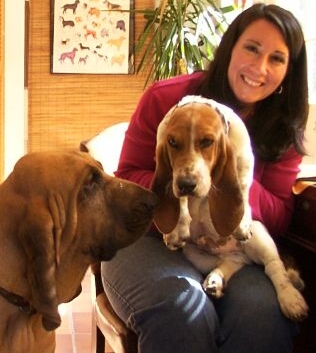
The Joy of Being a Hound Dog Family
The Joy of Being a Hound Dog Family With few exceptions, hounds make great family pets for those willing to care for them properly. The hound is adaptable and intelligent and will likely be the source of hours of good, hearty play time. Hounds have a sense of humor like few other breeds of dog. They enjoy play and fun as much as they enjoy the hunt and will likely be more like having another child than having a dog. Interactive and involved in family life the hound requires a dedicated owner, but has no problem returning the dedication shown it on an everyday basis. The hound is an affectionate breed that will openly and honestly enjoy you as much as you do it. An honest, straight-forward dog, this breed inspires dedication and near fanatical loyalty from those lucky enough to appreciate them.
If you are someone who wants a dog who lives to respond to your commands with hair-trigger speed- donít torture yourself with the hound group. While it is true that some hounds are easily taught and some do very well in obedience trials, as a whole the hound group is not the best choice for those who wish to become famous in obedience circles unless they are individuals who enjoy a real challenge.
 A person who needs a small dog can consider a hound as they come in many shapes and sizes such as the Dachshund and Beagle. A person who needs a small dog can consider a hound as they come in many shapes and sizes such as the Dachshund and Beagle.
Hounds are generally very healthy dogs. There is not a great deal of work involved in keeping them clean and healthy and most often they have a temperament guaranteed to bring joy to your life.
They are natural comedians and are constantly getting themselves into hilarious situations that seem to delight them as much as they delight the people they own ! You will seldom be able to walk very far with your hound without a passer-by at least giving you a smile if not stopping you to chat a while.
Oddly, most adopters hardly ever stop at just one hound. Perhaps it is because hounds are pack animals and seem to be more comfortable with another hound around. At any rate , their adopters seem to sense that and having adopted one hound, they immediately set about finding their next. Please keep us in mind!

A Little About Coonhounds in Particular
The Coonhound is one of the few truly American breeds. Early settlers of the America's had at their disposal many European breeds of hunting dog. These European dogs faced particular challenges in hunting in the thick forest and wild lands of America. The new terrain and differing game species brought rise to a need for a new breed of hunting dog. A dog with honed tracking and scenting skill. A tireless, powerful, agile dog able to work in thick forest as well as open field. Enter the American Coonhound. A blending of breeds, sampling the unique talents of these varied breeds led to the development of this wonderfully charming and talented dog. A courageous hunter and loyal friend, the Coonhound one of the best dogs the hound world has to offer.
When one hears "Coonhound" mentioned most people think of the American Black and Tan Coonhound. The Black and Tan is without a doubt the most recognizable of the Coonhound breeds, but is only one of the six different breeds of Coonhound.
The Six Breeds
There are six different breeds of Coonhound. Each breed has its own unique talents and purpose in the hunting arena.
 The most recognized of the six breeds is the American Black and Tan Coonhound. Those passionate about the Black and Tan will claim it to be the "original" Coonhound. Believed to be descended from the Talbot Hound, the Black and Tan is classic coonhound. Typically heavier than the other Coonhound breeds (75-100 lbs), the Black and Tan is the largest of the Coonhound breeds. This is a sturdy dog with heavy structure. Powerful and surprising agile, the Black and Tan can out-maneuver and out-work most other breeds its size. The Black and Tan also possesses a classic hound voice. The Black and Tan is a great family dog and is known for being both tolerant and patient pets. The most recognized of the six breeds is the American Black and Tan Coonhound. Those passionate about the Black and Tan will claim it to be the "original" Coonhound. Believed to be descended from the Talbot Hound, the Black and Tan is classic coonhound. Typically heavier than the other Coonhound breeds (75-100 lbs), the Black and Tan is the largest of the Coonhound breeds. This is a sturdy dog with heavy structure. Powerful and surprising agile, the Black and Tan can out-maneuver and out-work most other breeds its size. The Black and Tan also possesses a classic hound voice. The Black and Tan is a great family dog and is known for being both tolerant and patient pets.
 Next is the Redbone Coonhound. Somewhat sleeker than the Black and Tan, the Redbone has powerful appearance. Its slim, muscular build makes it appear as though this dog is moving even when it is standing still. Lighter in structure than the Black and Tan, the Redbone weighs in at around 60pounds, though there are many breeding for a larger Redbone and it is not uncommon to see this dog as big as 80 lbs. Having less loose skin than the Black and Tan and being the only solid colored dog of the Coonhound breeds (a black saddle or blanket still appears on some dogs from time to time), the Redbone is not immediately recognized as a Coonhound by people unfamiliar with the breed. The Redbone is all Coonhound though and has the skills to prove it. The name Redbone is a kind of slang for "any dog, red in color, of unknown origin." The origin of this dog is known however. Descended from Irish hounds, the Redbone is a hard working hunting dog with a nearly endless well of energy for its task. The Redbone is a confident, outgoing dog that is good with family but may prove sensitive to strangers. Next is the Redbone Coonhound. Somewhat sleeker than the Black and Tan, the Redbone has powerful appearance. Its slim, muscular build makes it appear as though this dog is moving even when it is standing still. Lighter in structure than the Black and Tan, the Redbone weighs in at around 60pounds, though there are many breeding for a larger Redbone and it is not uncommon to see this dog as big as 80 lbs. Having less loose skin than the Black and Tan and being the only solid colored dog of the Coonhound breeds (a black saddle or blanket still appears on some dogs from time to time), the Redbone is not immediately recognized as a Coonhound by people unfamiliar with the breed. The Redbone is all Coonhound though and has the skills to prove it. The name Redbone is a kind of slang for "any dog, red in color, of unknown origin." The origin of this dog is known however. Descended from Irish hounds, the Redbone is a hard working hunting dog with a nearly endless well of energy for its task. The Redbone is a confident, outgoing dog that is good with family but may prove sensitive to strangers.
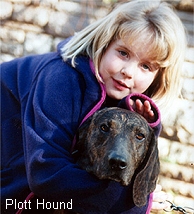 The Plott Hound is perhaps the least known of the six breeds. The Plott is said to be the only of the six Coon breeds not to have been bred with Foxhound in its development. The ancestors of this brindle-colored hound were used for hunting wild boar in Germany. Once in America, the hound was used to hunt bear. With some careful and selective breeding by dedicated people, the Plott hound was born. This is a courageous dog who takes his skills seriously. The Plott is a courageous, even tempered dog but will need plenty of exercise to be healthy and to stay away from trouble. The Plott Hound is perhaps the least known of the six breeds. The Plott is said to be the only of the six Coon breeds not to have been bred with Foxhound in its development. The ancestors of this brindle-colored hound were used for hunting wild boar in Germany. Once in America, the hound was used to hunt bear. With some careful and selective breeding by dedicated people, the Plott hound was born. This is a courageous dog who takes his skills seriously. The Plott is a courageous, even tempered dog but will need plenty of exercise to be healthy and to stay away from trouble.
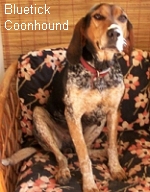 The second largest of the Coonhound family, the Bluetick weighs in about 60 to 80 pounds. The name "Bluetick" is derived from the black spotted coat. This spotting, called dappling, freckling, and by many other names in other breeds, is called "ticking" in hounds. The Bluetick is a highly energetic and intense hunter that will have a hard time adjusting to life in suburbia. This dog is bold in the field and goes about its hunting tasks with fervor. An intelligent dog with a quick mind, this Coonhound loves to work and will need large amounts of daily exercise. This is a headstrong, confident dog who does not mind being in charge of things. Good with family and loyal, you will still need to keep this dog on a leash or contained to keep it from roaming. The second largest of the Coonhound family, the Bluetick weighs in about 60 to 80 pounds. The name "Bluetick" is derived from the black spotted coat. This spotting, called dappling, freckling, and by many other names in other breeds, is called "ticking" in hounds. The Bluetick is a highly energetic and intense hunter that will have a hard time adjusting to life in suburbia. This dog is bold in the field and goes about its hunting tasks with fervor. An intelligent dog with a quick mind, this Coonhound loves to work and will need large amounts of daily exercise. This is a headstrong, confident dog who does not mind being in charge of things. Good with family and loyal, you will still need to keep this dog on a leash or contained to keep it from roaming.
 Originally called and registered as the English Fox and Coonhound before the specialization of the six breeds as well as the registering of Walker and Blueticks as separate breeds in the 40's, the English Coonhound may hail back to English hounds. However, present day English Coonhounds were perfected right here in the USA. Sometimes called the Redtick Coonhound, the red pattern (as in photo) is the most common and "favored" coloration, though the shared ancestry of the English, Bluetick, and others allow this hound to come in with black ticking, tri-coloration, and a mix of the three. Persons dedicated to the breed claim this to be the source of other hound breeds and the standard for the Coonhound family. The English is a strong and agile dog. Friendly and outgoing, the English, though not mild-tempered, is well-tempered and good with families willing to exercise them regularly. Originally called and registered as the English Fox and Coonhound before the specialization of the six breeds as well as the registering of Walker and Blueticks as separate breeds in the 40's, the English Coonhound may hail back to English hounds. However, present day English Coonhounds were perfected right here in the USA. Sometimes called the Redtick Coonhound, the red pattern (as in photo) is the most common and "favored" coloration, though the shared ancestry of the English, Bluetick, and others allow this hound to come in with black ticking, tri-coloration, and a mix of the three. Persons dedicated to the breed claim this to be the source of other hound breeds and the standard for the Coonhound family. The English is a strong and agile dog. Friendly and outgoing, the English, though not mild-tempered, is well-tempered and good with families willing to exercise them regularly.
 The Treeing Walker Coonhound is lighter and faster than the other similiar breeds.This tri-colored hound is preferred although bicolors do exist.Tan and white Treeing Walkers are not described as "red" to avoid confusion with the Redbone coonhound.This breed descended from English Foxhounds and the development of this coonhound involved a hound stolen in the 1800's. This hound named Tennessee Lead, added speed and treeing ability to the line. This hound is still used for hunting raccoons and opossums. Here at HOMEWOODS our resident Treeing Walker serves the soul purpose of a doorstop. The Treeing Walker Coonhound is lighter and faster than the other similiar breeds.This tri-colored hound is preferred although bicolors do exist.Tan and white Treeing Walkers are not described as "red" to avoid confusion with the Redbone coonhound.This breed descended from English Foxhounds and the development of this coonhound involved a hound stolen in the 1800's. This hound named Tennessee Lead, added speed and treeing ability to the line. This hound is still used for hunting raccoons and opossums. Here at HOMEWOODS our resident Treeing Walker serves the soul purpose of a doorstop.
Coonhound Health
The lack of popularity as a pet breed has kept the Coonhound a healthy breed. The majority of Coonhounds are bred by and for hunters or by others dedicated to the breed and its health. Commercial and backyard breeders have not had much opportunity to foul up the Coonhound yet, so many of the health issues plaguing other medium/large popular pet breeds are not as prevalent in the Coonhound. This does not mean that there are not health issues with the Coonhound. While they can have any problem that any other dog can have, including hip and joint problems, bloat, and turned stomachs, these problems are not common enough to have become a stereotypical breed characteristic. For example, many people automatically associate retrievers with cancer, Rottweilers with hip problems, Dobermans with neurological disease, etc. As always, research, careful selection of breeder and pup will go a long way to having a healthy adult. As with any hound, it may be difficult to control the weight of an inactive individual.
|

